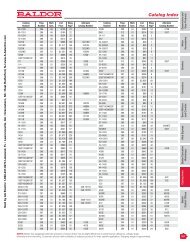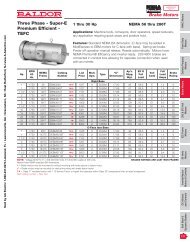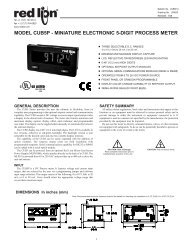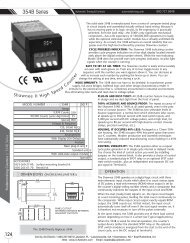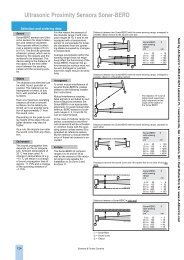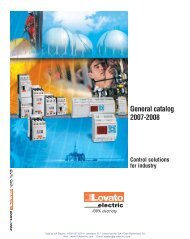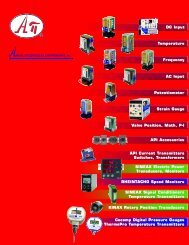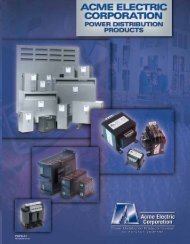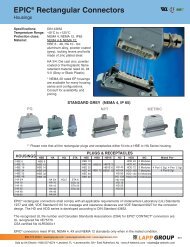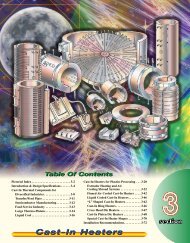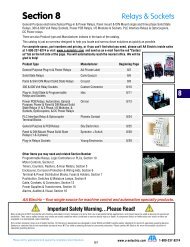G - AA Electric
G - AA Electric
G - AA Electric
You also want an ePaper? Increase the reach of your titles
YUMPU automatically turns print PDFs into web optimized ePapers that Google loves.
Relay coupler – overview<br />
Definition of the technical data<br />
Sold by <strong>AA</strong> <strong>Electric</strong> 1-800-237-8274 Lakeland, FL • Lawrenceville, GA • Greensboro, NC • East Rutherford, NJ www.A-Aelectric.com<br />
Protective separation<br />
All equipment guaranteeing “protective<br />
separation” is to be designed so that any<br />
faults (e.g. mechanical faults) cannot<br />
affect the insulation. If a mechanical fault<br />
occurs in a relay (bent soldering post,<br />
broken winding wire or broken spring),<br />
“protective separation” must also be guaranteed<br />
in such cases.<br />
Relays are specified and tested to<br />
IEC 255 and VDE 0435. Neither standard<br />
makes reference to EN 50 178 (electronic<br />
equipment for use in high current installations),<br />
nor do they contain a definition of<br />
“protective separation”. Furthermore,<br />
other measuring conditions are used as<br />
the basis for the test voltages stated for<br />
the relays. So the test voltages cannot be<br />
transferred to EN 50 178 or<br />
DIN VDE 0106 part 101. In view of the<br />
fact that users are increasingly turning to<br />
equipment which guarantees “protective<br />
separation”, many relay manufacturers<br />
now refer to DIN VDE 0106 and test their<br />
products accordingly. The stated values<br />
then correspond with “protective separation”.<br />
Standards<br />
The following standards are fulfilled:<br />
• EN 50 178:<br />
Electronic equipment for use in high<br />
current installations<br />
• DIN VDE 01206 part 101:<br />
Protection from dangerous body currents,<br />
basic requirements for “protective<br />
separation” in electrical equipment<br />
• IEC 255, DIN VDE 0109:<br />
Insulation coordination for equipment<br />
within low-voltage systems, including<br />
clearance and creepage distances for<br />
configured printed circuit boards<br />
• DIN VDE 0435:<br />
<strong>Electric</strong>al relays, switching relays<br />
Input curcuit<br />
Rated voltage [V]<br />
Rated current [mA]<br />
Nominal consumption [W/VA]<br />
Operating voltage [V]<br />
Pull-in current [mA]<br />
Response power [W/VA]<br />
Drop-out voltage [V]<br />
Release current [mA]<br />
Output circuit<br />
Max. switching voltage [V]<br />
Switch-on current [A]<br />
Continuous current [A]<br />
Switching power [W/VA]<br />
Min. switching power [µW]<br />
Service life<br />
Response time [ms]<br />
Release time [ms]<br />
Switching frequency [Hz]<br />
Voltage strength [kV]<br />
Reference voltage at which the relay coupler works<br />
Typical input voltage<br />
=> 5 Vdc, 12, 24, 48, 60, 115, 230 ac/dc<br />
Quotient of input voltage and input resistance<br />
Input resistance => coil resistance + resistance of the triggering<br />
device (R; LED; GL, …)<br />
Input voltage x input current dc/ac<br />
with tolerance +/-10% or +5/-15%<br />
typical range for relay coupler<br />
250 mW > Pv > 1 W 0.4 VA > Pv > 1.2 VA<br />
Smallest input current needed for the relay coupler to respond<br />
(Tu = 293 K)<br />
Smallest input current at which the relay switches from idle to<br />
working position<br />
(Tu = 293 K)<br />
Product of operating voltage and pull-incurrent<br />
Voltage at which the relay reliably drops away<br />
Input current at which the relay reliably drops away<br />
Max. voltage allowed at the relay contact<br />
Current allowed to flow for max. 4 seconds after the relay contact<br />
closes<br />
Current allowed to flow constantly after the contact closes<br />
Product of output voltage and switch-on current, under ohmic,<br />
inductive or capacitive load<br />
Smallest power to be switched via the contact<br />
No. of switching cycles until the contact fails<br />
– mechanical => without electric load<br />
– electrical => under ohmic or inductive ac/dc load<br />
Time from closing the exciter voltage until the contact<br />
closes/opens<br />
Time from opening the exciter voltage until the contact<br />
closes/opens<br />
Switching circuits/sec. in pulse duty factor 1:2 (ton = toff)<br />
Max. test voltage between input and output circuit which does<br />
not cause a discharge<br />
Protective separation Relay coupler acc. to EN 50178 or VDE 0106 part 101<br />
Light arc<br />
Flow of current on opening contacts, caused by ionisation<br />
Contact wear<br />
The switching of inductivity causes extensive material migration<br />
Results:<br />
=> Scratches and tip formation on contact surfaces<br />
=> Failure caused by contacts interlocking<br />
Spark extinction<br />
Limitation of transient overvoltage by switching<br />
the inductive load:<br />
=> RC combinations<br />
=> Z-diodes / suppressor diodes<br />
=> varistors<br />
Reduction factor<br />
Factor by which the service life is reduced when switching inductive<br />
loads<br />
Relay coupler<br />
K<br />
K.5



